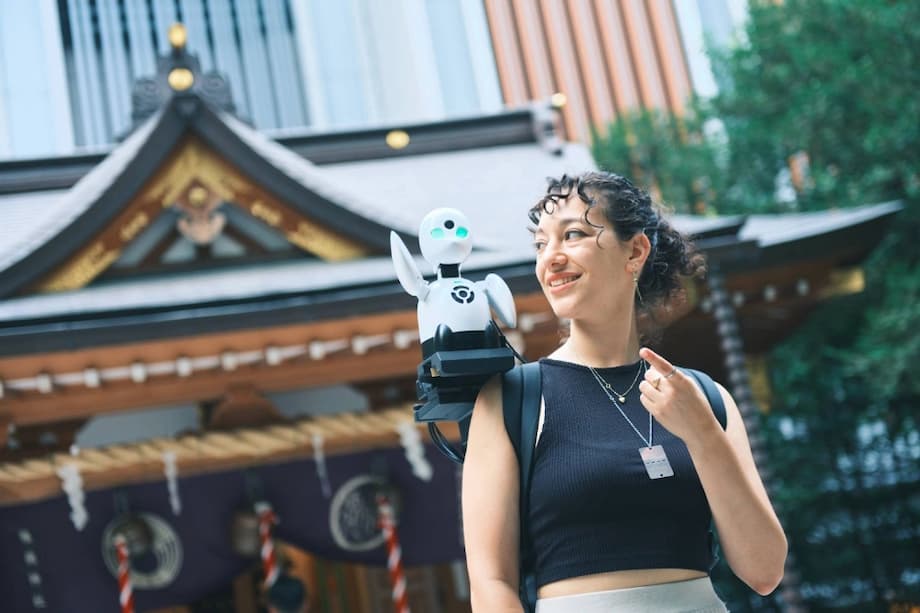Why avatar robots are guiding tourists in Nihonbashi
In Tokyo’s Nihonbashi business district, groups of visitors now walk the streets with a small white robot perched on a traveler’s shoulder. The device is OriHime, an avatar robot from OryLab that serves as a live tour guide. A human operator, known as a pilot, controls the robot remotely, speaking through its speaker, seeing through its camera, and engaging in two way conversations as the group explores shops, shrines, and back lanes. The goal is compelling and practical at once. People who cannot easily leave home because of disability, chronic illness, or caregiving responsibilities can work as guides. Tourists get a local perspective, in either English or Japanese, delivered by someone who knows the city and wants to connect. The setup turns telepresence into a structured job that is social, creative, and public facing.
- Why avatar robots are guiding tourists in Nihonbashi
- How the shoulder robot tour works
- Who are the pilots and how do they work?
- Inside Nihonbashi’s walking route
- The tech inside OriHime
- Partnerships and business model
- How visitors are responding
- What challenges remain
- Japan’s wider embrace of social robots
- What to Know
The robot is mounted on a stand attached to a backpack worn by one person in the group. Because OriHime sits near head level, the pilot can chat naturally, react to sights around the corner, and answer questions. The experience feels more like meeting a host who happens to be embodied in a small, birdlike robot than listening to a preprogrammed audio track. The experiment is part of a growing effort in Japan to use avatar robots to expand work options and bring new kinds of hospitality to life.
How the shoulder robot tour works
OriHime weighs about four kilograms and sports glowing green eyes and winglike arms that gesture as it speaks. The robot carries a camera, microphone, and speaker set, so the pilot can see, listen, and talk in real time. When the group stops at a shrine, OriHime can fold its arms together in a posture akin to prayer. The physical design is intentionally simple. That design choice keeps attention on the voice and story of the person behind the robot, which is central to the experience.
The pilot connects from home or a care setting and directs the tour through the traveler’s shoulder unit. Tour narration, questions, and small talk pass through the robot’s mic and speaker with minimal delay. English and Japanese support means groups can include international visitors and local residents. Conversation flows as if a guide were walking alongside, because the robot sits close to the wearer’s ear and mouth, and ambient street sounds blend in like any city walk.
From cafe counter to city streets
The tours grew out of a concept proven inside Avatar Robot Cafe DAWN in Nihonbashi. At the cafe, pilots serve customers, prepare drinks with a tele-barista system, and host tables while operating robots from home. The cafe model showed that remote work could be energizing for staff and enjoyable for guests. Extending that model to walking tours takes the social connection beyond a counter and into the neighborhood. The route ties together small businesses, historical sites, and cultural etiquette, so the pilot can steer both conversation and direction.
OryLab describes the larger mission behind these projects in its official materials. The company presents the cafe and its avatar robots as tools for participation, work, and connection, aimed at people who are housebound or bedridden. In words the company uses to explain its purpose:
We aim to achieve a new form of social participation through the use of technology.
Who are the pilots and how do they work?
Pilots are the human operators behind OriHime. Many have conditions such as amyotrophic lateral sclerosis, spinal muscular atrophy, muscular dystrophy, multiple sclerosis, or severe mobility impairments. Some live far from Tokyo, and others are local residents who cannot commute or stand for long periods. Pilots control OriHime using a mouse, tablet, or gaze tracking interface. They can speak naturally through the robot or use text to speech when needed. The operator’s view comes from the camera on the robot, and a support team can help with logistics and safety checks when a group is outside.
The DAWN cafe already employs dozens of pilots who log in from homes and hospitals to work shifts across different roles. The walking tours add a new category of paid work that is mobile and dialog driven. Training covers tour routes, local history, cross cultural communication, and how to handle varied accessibility needs within a group. The model aims to match each pilot’s strengths to tasks, keep shifts flexible, and create a sense of teamwork that does not require physical presence in a single workplace.
Inside Nihonbashi’s walking route
The OriHime tour typically begins at the DAWN cafe in Nihonbashi, then winds through streets known for long established stores, artisan goods, and venerable shrines. The pilot introduces spots that regular tours often overlook, such as specialty shops with centuries of history or quiet corners with stories attached. When the group enters a shrine precinct, the pilot can explain etiquette, from rinsing hands to approaching the main hall. Seeing the robot fold its small arms while the group pauses adds a human touch to a moment of reflection.
Operators often weave personal stories into the route. The style suits Nihonbashi, where tradition and modern commerce sit side by side. Visitors hear about family recipes, seasonal rituals, or the roots of a neighborhood shop. Many participants have described the experience using the Japanese phrase ichi go ichi e, meaning a once in a lifetime encounter. That idea fits the walk well. Every tour depends on the pilot’s perspective, the group’s interests, and the day’s mood, so conversations feel personal even when the route overlaps with other tours.
The tech inside OriHime
OriHime is a telepresence system tailored for social conversation, not a humanoid made to mimic a person. The robot has a compact body with a head, two arms, and expressive eyes that brighten or dim as the pilot speaks. The components play a clear role. The camera gives the pilot situational awareness, the mic captures close range voices, and the speaker projects a clear voice to the group. Power comes from internal batteries that can cover a walking tour schedule, and the backpack mount keeps the robot steady even in a crowd. The setup balances durability with comfort for the wearer and clarity for the pilot.
Connectivity is the hidden backbone. The system needs stable mobile data to keep audio responsive and the camera feed smooth. Engineers tune compression and buffering so the pilot can respond quickly when someone points at a sign or asks about a side street. OryLab treats privacy with care. The robot is a communications tool, not a surveillance device. Operators and support teams follow rules around recording, consent, and data handling, and groups are briefed on what the camera does and does not capture before a tour begins.
Why an abstract avatar helps the conversation
Designers of social robots often choose abstract forms on purpose. OriHime does not try to look human. That keeps attention on the voice, timing, and warmth of the person controlling it. Tour members react to what the pilot says, the tone of their comments, and the choices they make in conversation. The simple face avoids biases that can arise with humanlike models and gives pilots the freedom to express themselves through voice, wit, and knowledge rather than facial imitation.
Partnerships and business model
The tour program is a collaboration between OryLab and local partners focused on Nihonbashi’s streetscape and businesses. The starting point at the avatar robot cafe makes it easy to check equipment, meet the group, and set expectations before heading out. The route builds in stops where merchants welcome tour groups, and English speaking service is available. The neighborhood benefits from visitor flow, and the pilot gains paid work in a format that revolves around storytelling and cultural exchange.
Organizers plan to expand the concept as training and logistics mature. Avatar guided experiences can fit museums, airports, and office complexes, where people who cannot commute or stand for long periods can still greet, guide, and assist guests. The cafe’s official site lists accessibility features and program details for those who want to learn more or visit in person. Information is available at Avatar Robot Cafe DAWN.
How visitors are responding
Early participants describe the walks as friendly, surprising, and easy to follow. Foreign visitors appreciate that a bilingual pilot can cover history and answer practical questions without the formality of a large group tour. The shoulder position keeps the voice close and present even on busy streets, so conversation feels like a chat with a local rather than a broadcast. Some travelers have made the cafe a stop on accessibility focused itineraries because it demonstrates how remote work can turn into face to face hospitality.
Residents in Tokyo tend to greet social robots with curiosity rather than skepticism. The country has years of exposure to robots that help in shops, stations, and care homes. A friendly avatar that tells stories and points out a confectionery founded generations ago fits that familiar pattern. The technology recedes and the person behind the robot becomes the focus for most guests.
What challenges remain
Keeping the experience smooth outside a controlled space requires attention to detail. Mobile networks can vary from block to block, and a brief drop can interrupt the pilot’s view or voice. Organizers schedule routes with signal strength in mind and provide support staff who can help the pilot reposition the group if the connection dips. Weather is another factor. Rain, heat, and wind change how groups move and how a speaker sounds. Equipment must handle those changes without adding weight or discomfort to the wearer.
Hardware comfort is a priority. The backpack mount needs to balance the robot’s weight so the wearer can walk comfortably for the duration of a tour. Street noise can mask a voice in busy zones, so audio processing and careful route choices help keep conversation clear. Training covers how to manage group safety at crossings and how to use the robot’s gestures to cue attention. Continuous feedback from pilots and guests shapes refinements to each part of the setup.
Japan’s wider embrace of social robots
Japan’s demographic profile and labor market have pushed companies and communities to adopt robots in service roles for years. Care facilities use companion robots and mobility aids to support residents and ease strain on staff. Shops and transit hubs deploy guidance robots to direct visitors and provide information. Government programs have funded research and pilots for caregiving technologies, with the aim of addressing worker shortages and improving quality of life. Popular culture has long presented robots as helpers, which shapes public comfort with seeing them in everyday settings.
That broader context makes avatar guided tours feel natural, not gimmicky. The OriHime model does not replace human guides. It extends the reach of people who want to guide but cannot be on site. The work is social, paid, and rooted in real neighborhoods. Visitors receive a thoughtful introduction to a district, and pilots gain a way to show their city without leaving their home.
What to Know
- Avatar robot tours in Nihonbashi use OryLab’s OriHime, controlled remotely by a human pilot.
- The robot sits on a traveler’s shoulder via a backpack mount and speaks in English or Japanese.
- Pilots are paid workers, many of whom cannot leave home because of disability or illness.
- Tours begin at Avatar Robot Cafe DAWN and visit shrines, historic shops, and local landmarks.
- OriHime carries a camera, mic, and speaker, and can gesture and fold its arms at shrines.
- The program aims to widen employment and social participation through telepresence.
- Partnerships with local businesses bring visitor flow to neighborhood merchants.
- Stable connectivity, comfortable mounts, and clear audio are key to a smooth walk.
- Japan’s long experience with social robots supports public acceptance of avatar guides.
- Organizers see potential for similar roles in museums, stations, and corporate campuses.




